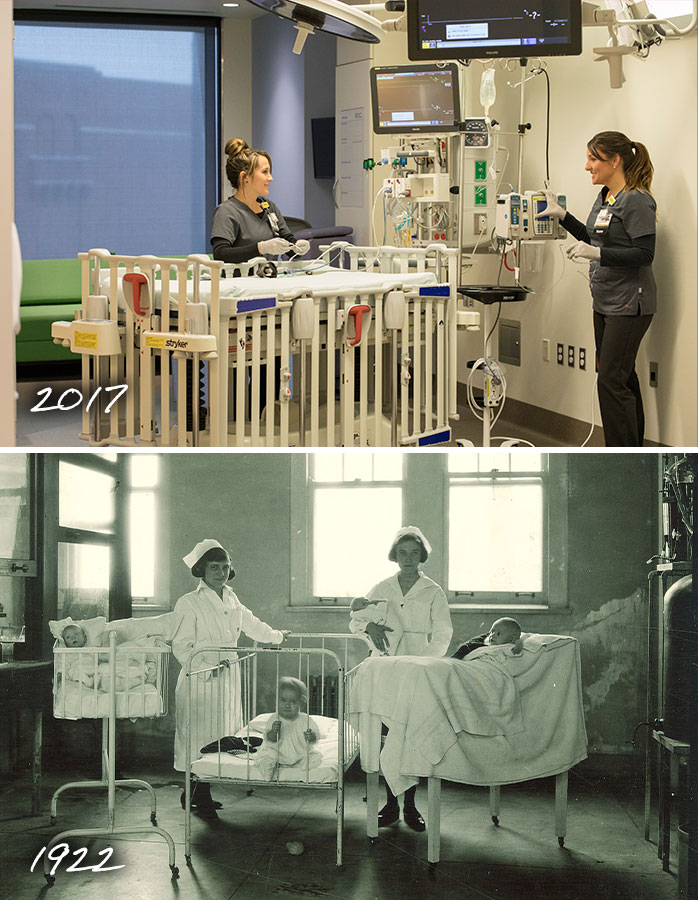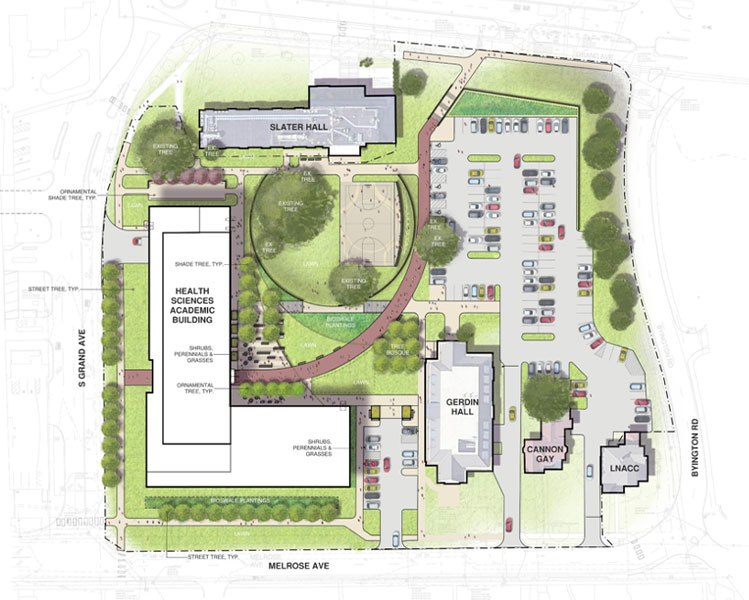Iowa's Evolution
In the early days of the State University of Iowa, an iron fence enclosed the modest campus and the not-so-old Old Capitol. This sturdy barrier was necessary at a time when pigs and other livestock occasionally strayed from nearby homesteads and caused mischief in what was still, in many ways, a frontier town.
That was the last time anyone tried to fence in the University of Iowa. Since welcoming its inaugural class of 124 students in 1855, the UI has steadily grown to meet its core mission of education, research, and service. Today, the university is home to more than 30,000 students who populate hundreds of world-class academic buildings, scientific laboratories, medical clinics, and athletics venues across 1,900 acres.
The launch of the university’s Together Hawkeyes comprehensive campaign promises to reshape our historic campus once again. In that spirit of progress, let’s look back on how far we’ve come and what’s on the horizon for the UI and its Hawkeye community.
CENTRAL CAMPUS
PHOTOS: UI LIBRARIES SPECIAL COLLECTIONS AND UNIVERSITY ARCHIVES/JASON SMITH Move the slider across the photo to see the evolution of the Iowa Memorial Union.• WHERE WE STARTED:
The UI’s story, of course, begins with the Old Cap. It was here on the bluff overlooking the Iowa River that the first General Assembly in 1847 established a university to train the new state’s doctors, lawyers, and other professionals. When the state legislature moved to Des Moines a decade later, Old Cap became the university’s first permanent address. A variety of buildings sprung up around the golden dome in the 19th century but were later supplanted by the four grand Greek revival-style edifices, built between 1902 and 1924, that make up today’s Pentacrest.
Meanwhile, several other landmarks took shape in the first decades of the 20th century. Currier Residence Hall, the UI’s oldest existing dormitory, opened in 1914 as a home for Hawkeye women. The Iowa Memorial Union debuted in 1925 as a hub for concerts, dances, and dinners. And just down Madison Street from the IMU, the Main Library consolidated much of the university’s vast book collection when it opened in 1951. By the latter half of the 20th century, the UI began to commission some of the world’s most noted architects for new buildings—Frank Gehry designed the Iowa Advanced Technology Laboratories, for instance—transforming campus into what’s been called a living textbook of modern architectural history.
• WHERE WE ARE:
The Pentacrest remains at the heart of university life. Its leafy lawn hosts pep rallies, homecoming concerts, and daily study sessions, while Pentacrest Museums welcome tours of the Old Cap and Museum of Natural History. The IMU, meanwhile, was swamped by the flood of 2008, leading to a renovation of its lower level and the construction of a new floodwall integrated into an outdoor terrace. In 2014, the Main Library’s first floor was redesigned as a student learning commons with group study rooms, a café, and technology upgrades.
Nearby, the UI’s newest dormitory, Elizabeth Catlett Residence Hall, opened in 2017 and is home to several Living Learning Communities. The UI has also cut the ribbon on several transformative academic and research buildings in recent years, including the Psychological and Brain Sciences Building (2019) and Nonfiction Writing House (2023).
• WHERE WE’RE GOING:
The UI unveiled its ambitious 10-year facilities master plan last year that, while it could evolve or change, calls for renovations to some of the main campus’ most historic buildings. The plan would modernize MacLean, Jessup, and Macbride halls for academic use, and the Main Library is slated for a renewal project.
The IMU is scheduled to begin a new round of renovations in 2024, including a new Well-Being and Mental Health Center that will bring together the UI’s health, counseling, and wellness resources under one roof. Other priorities on the horizon include a new location for the UI’s cultural centers and expanding the Tippie College of Business.
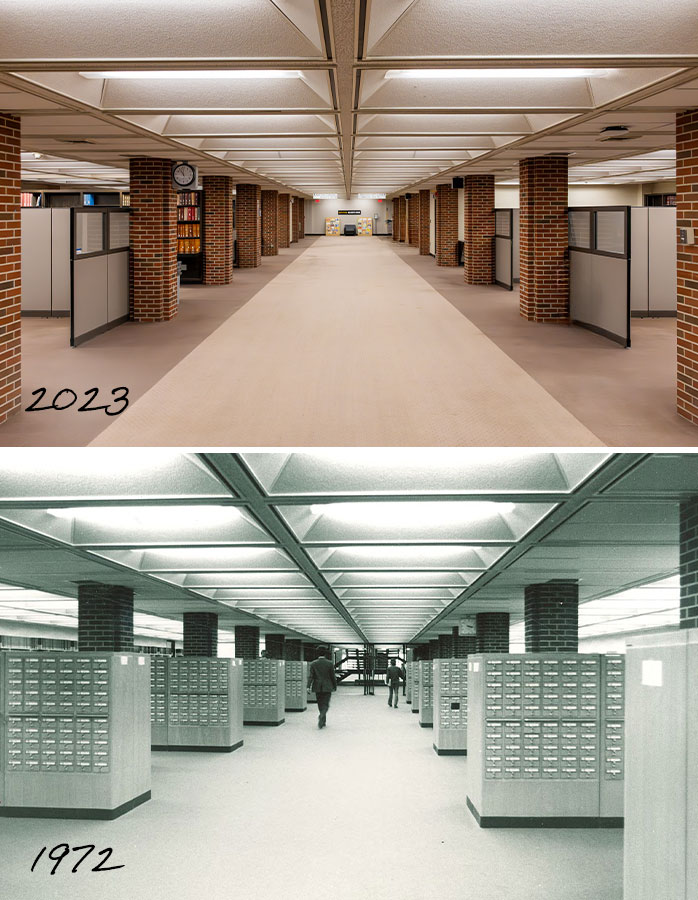 Click to enlarge
Click to enlarge
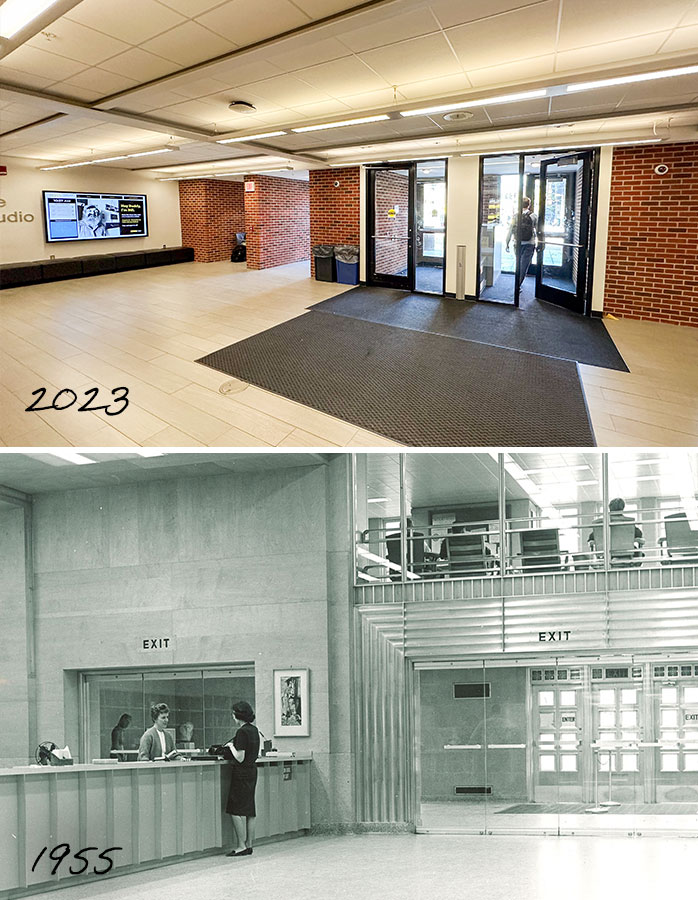 Click to enlarge
Click to enlarge
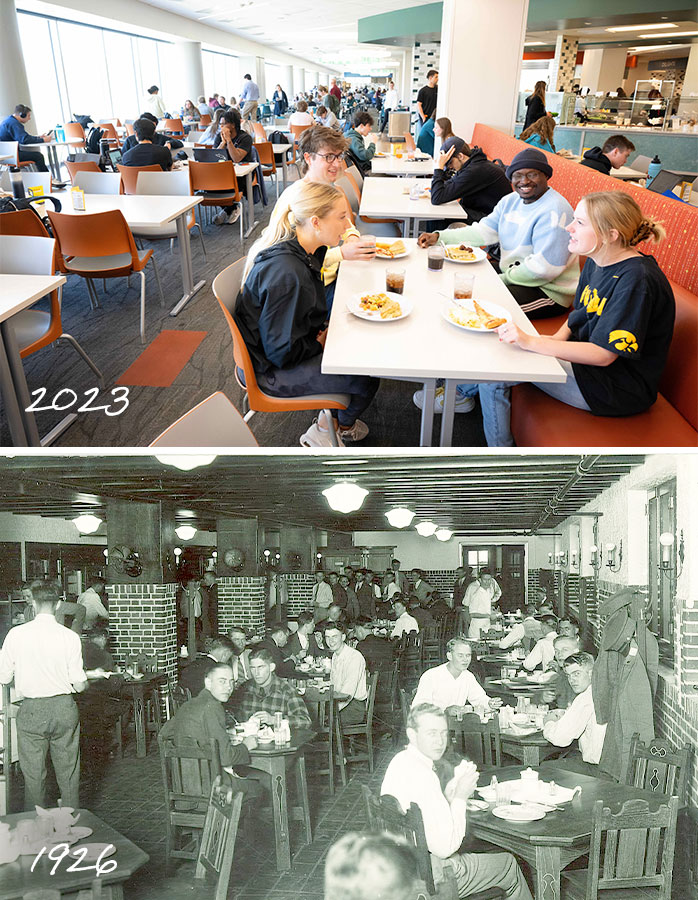 Click to enlarge
Click to enlarge
MEDICAL CAMPUS
PHOTOS: UI LIBRARIES SPECIAL COLLECTIONS AND UNIVERSITY ARCHIVES/UI OFFICE OF STRATEGIC COMMUNICATION Photos depict the growth of Iowa's medical campus from General Hospital to include research labs, classroom space, the UI Hospitals & Clinics, and Stead Family Children's Hospital.• WHERE WE STARTED:
In 1870, the first class of 37 medical students convened in Iowa City, including eight women, making Iowa the first coeducational med school in the U.S. The first university-based teaching hospital west of the Mississippi River opened on the university’s main campus in 1898—a 50-bed facility (later renamed Seashore Hall) built at a cost of $55,000. The medical campus took shape on the west side of the Iowa River in the early 20th century, including the opening of the original children’s hospital in 1919, the psychiatric hospital in 1921, and the General Hospital with its historic gothic tower in 1928.
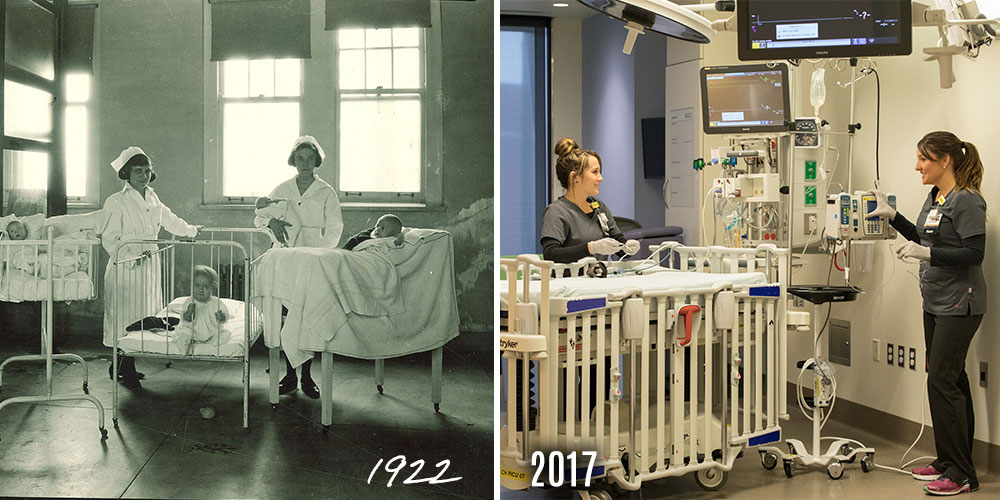 Click to enlarge
Click to enlarge
• WHERE WE ARE:
UI Hospitals & Clinics is one of the nation’s largest teaching hospitals with 16,500 employees, students, and volunteers. Each year, patients make more than 1 million clinic visits to the main medical campus and outreach clinics from Dubuque to Sioux City. The highly ranked Carver College of Medicine, meanwhile, is situated on an ever-growing health sciences campus that features 11 buildings housing classrooms, laboratories, and clinics. In the past decade alone, the Pappajohn Biomedical Discovery Building (2014), Stead Family Children’s Hospital (2017), and College of Pharmacy Building (2020) have opened their doors.
 Click to enlarge
Click to enlarge
• WHERE WE’RE GOING:
Construction at UI Health Care’s new North Liberty medical campus is ongoing and is set to open in 2025. Featuring 36 inpatient beds, 84 exam rooms, 14 emergency care treatment rooms, and 12 operating rooms, the new location will provide greater access to patients while training the next generation of physicians.
Construction has also begun just south of Slater Hall on the future Health Sciences Academic Building, which will be home to three nationally ranked programs: communications sciences and disorders, physical therapy, and health and human physiology. At the same time, UI Hospitals & Clinics is in the planning stages for a new inpatient tower that would add more than 200 beds to its main medical campus, sparked by a $70 million gift from the Richard O. Jacobson Foundation.
ATHLETICS CAMPUS
PHOTOS: UI LIBRARIES SPECIAL COLLECTIONS AND UNIVERSITY ARCHIVES/HAWKEYESPORTS.COM Built in 1929 to accommodate 53,000 football fans, Iowa Stadium was renamed Kinnick Stadium in 1972 and now holds 69,250 spectators.• WHERE WE STARTED:
Iowa played its first football and baseball games on fields along the east banks of the Iowa River in the 19th and early 20th centuries. Close Hall, a multipurpose building downtown, was the site of the nation’s first five-on-five college basketball game in 1896, while the women’s gymnasium, Halsey Hall, opened in 1915.
The Field House debuted in 1927, featuring what was at the time the world’s largest indoor collegiate pool, and Iowa Stadium—decades later renamed Nile Kinnick Stadium—opened in 1929. The latter half of the 20th century featured the 1983 construction of Carver-Hawkeye Arena, a subterranean marvel that garnered Iowa’s first national architectural design award and has hosted some of Iowa basketball and wrestling’s biggest moments along with countless concerts and graduations.
• WHERE WE ARE:
Iowa boasts some of the top athletics facilities in the Big Ten. Kinnick Stadium remains one of college football’s great cathedrals and has undergone several transformations, most recently the $89 million makeover in 2019 that enhanced the north end zone. Other key additions in recent decades include the West Campus Tennis Recreation Center (2006), Campus Wellness and Recreation Center (2010), Hansen Football Performance Center (2014), and the Soccer Operations Building (2022).
• WHERE WE’RE GOING:
The Goschke Family Wrestling Training Center, which is under construction and connects to Carver-Hawkeye Arena, will serve as the new practice home for the men’s and women’s grapplers when it opens in 2024.
Meanwhile, the university launched a nearly $24 million campaign earlier this year to revitalize the Iowa baseball complex and Duane Banks Field. And the Hawkeye Women: RISE campaign recently kicked off with the goal of building a new women’s gymnastics and Iowa Spirit Squads training center. Long-term planning is also under way to modernize Carver-Hawkeye Arena, which turned 40 this year.
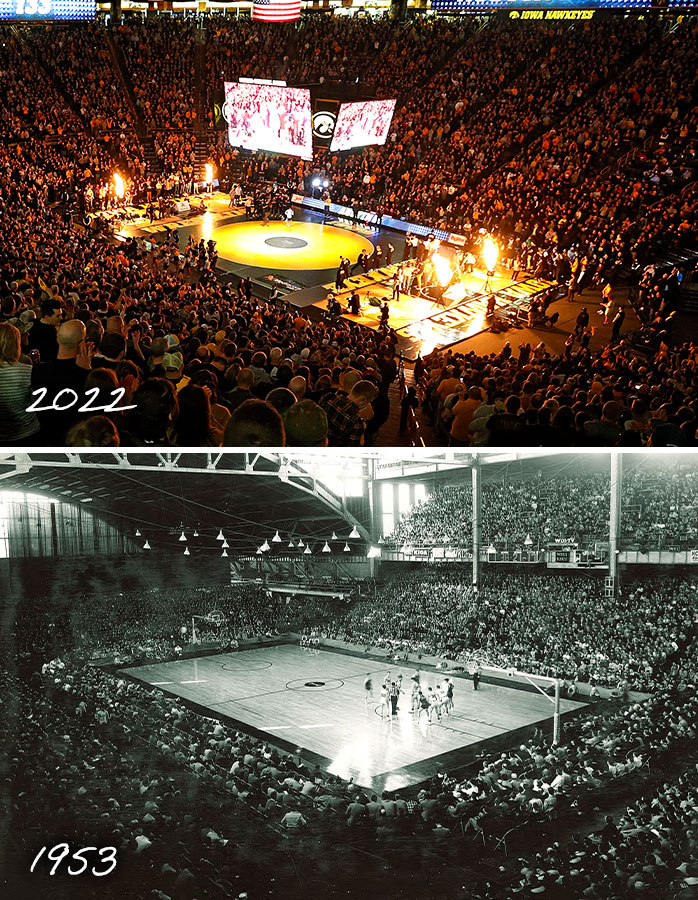 Click to enlarge
Click to enlarge
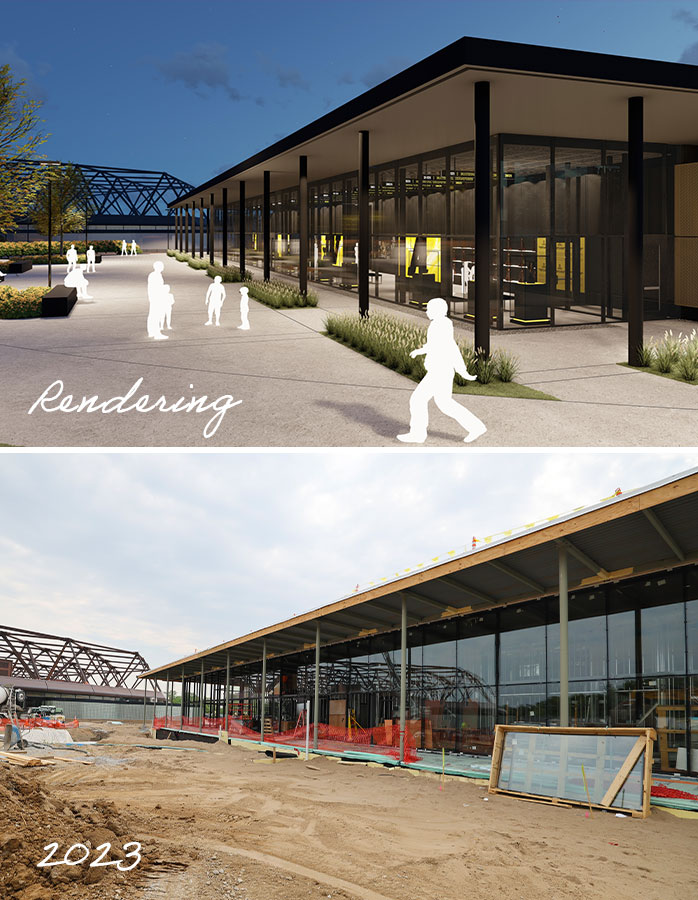 Click to enlarge
Click to enlarge
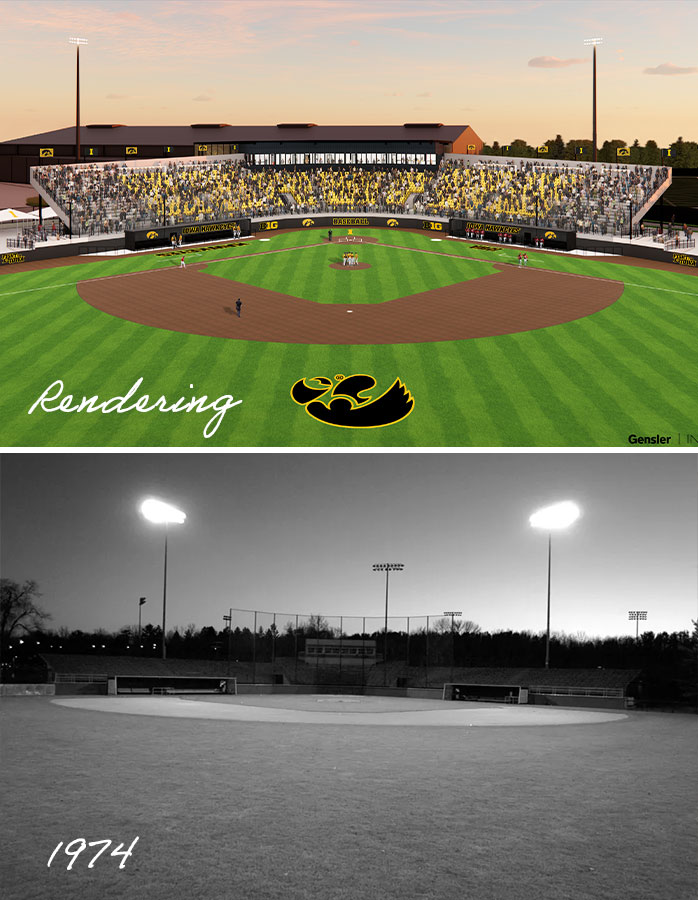 Click to enlarge
Click to enlarge
ARTS CAMPUS
PHOTOS: UI LIBRARIES SPECIAL COLLECTIONS AND UNIVERSITY ARCHIVES/UI OFFICE OF STRATEGIC COMMUNICATION Photos of the arts campus over time show the addition of the old Museum of Art, now known as the Performing Arts Annex, between the Art Building and Theatre Building.• WHERE WE STARTED:
The 1936 opening of the original Art Building—where professors like Grant Wood and Philip Guston worked and taught—established Iowa’s renown as a haven for artists on the west banks of the Iowa River. Nearby, the Theater Building raised its curtain a year later and would count Tennessee Williams (38BA) and Gene Wilder (55BA) among its students.
In 1969, the original UI Museum of Art became the home of one of the nation’s premier academic art collections, while Hancher Auditorium, Voxman Music Building, and Clapp Recital Hall debuted in 1972 to further establish Iowa City’s reputation in the performing arts.
• WHERE WE ARE:
The flood of 2008 changed everything at Iowa, and the arts campus was particularly devastated. The $750 million disaster led to the demolition of the original Hancher-Voxman-Clapp complex and the years-long displacement of the art museum collection and art, music, and theater programs. But the university turned disaster into a renaissance.
Iowa became a national model for flood prevention and recovery as it rebuilt Hancher (2016), a performing arts jewel that perches above the river uphill from the original site, and relocated Voxman Music Building downtown to create new campus and community connections. Meanwhile, the addition of award-winning Art Building West (2006) and the Visual Arts Building (2016) have propelled the School of Art and Art History into the 21st century, while the new Stanley Museum of Art brought home Jackson Pollock’s Mural and countless other masterpieces with its inaugural exhibition in 2022.
• WHERE WE’RE GOING:
The original Art Building and Museum of Art flooded in 2008, but both structures were preserved and could be given a second life as part of the UI’s 10-year facilities strategy. Plans are already taking shape to relocate the UI Dance Department from Halsey Hall to the former art museum, placing the state’s only comprehensive dance program in the heart of the arts campus. The old museum has served as a performing arts annex in recent years.
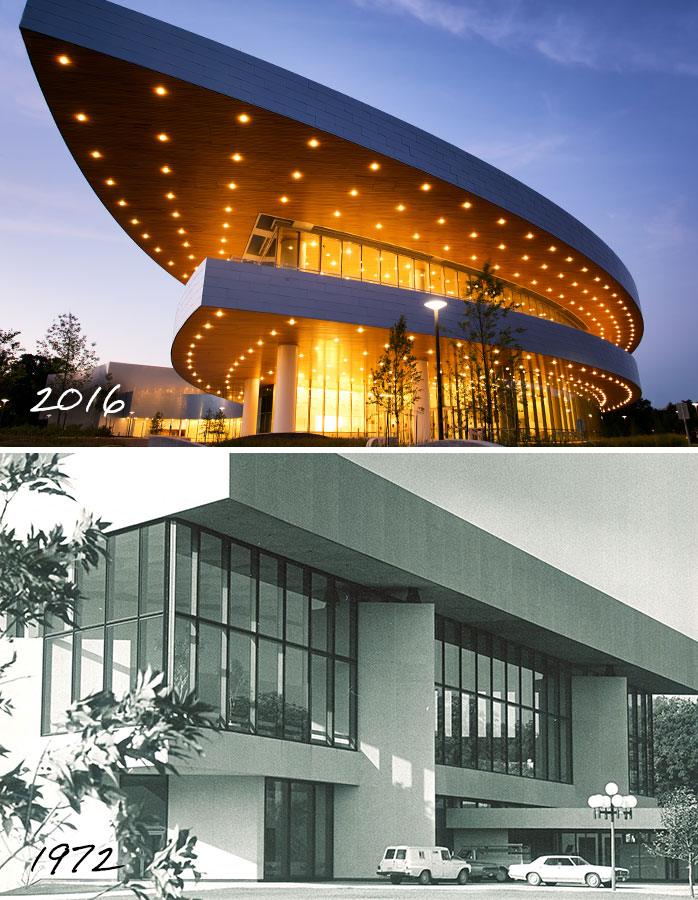 Click to enlarge
Click to enlarge
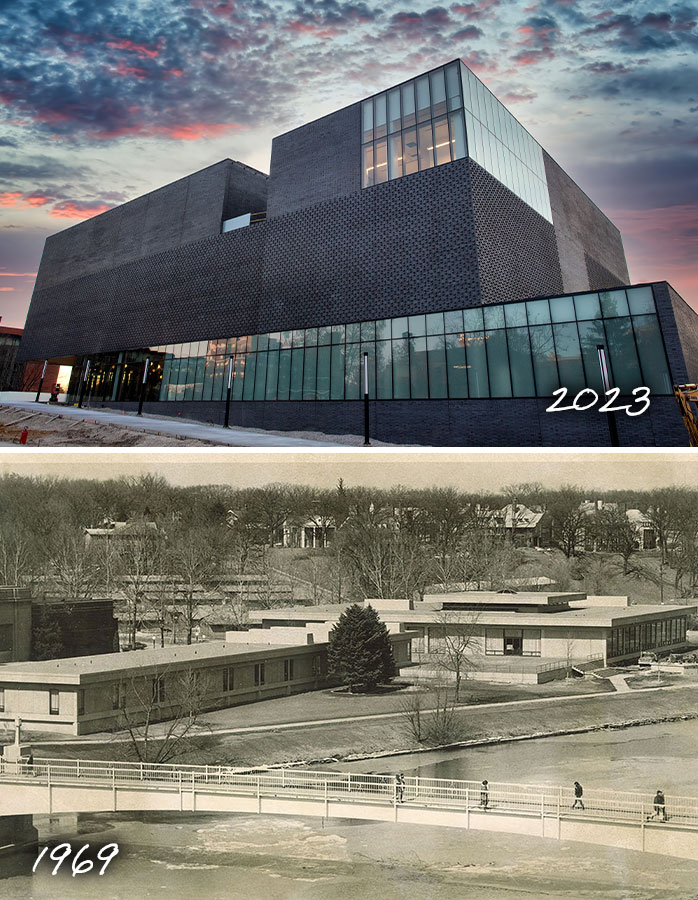 Click to enlarge
Click to enlarge
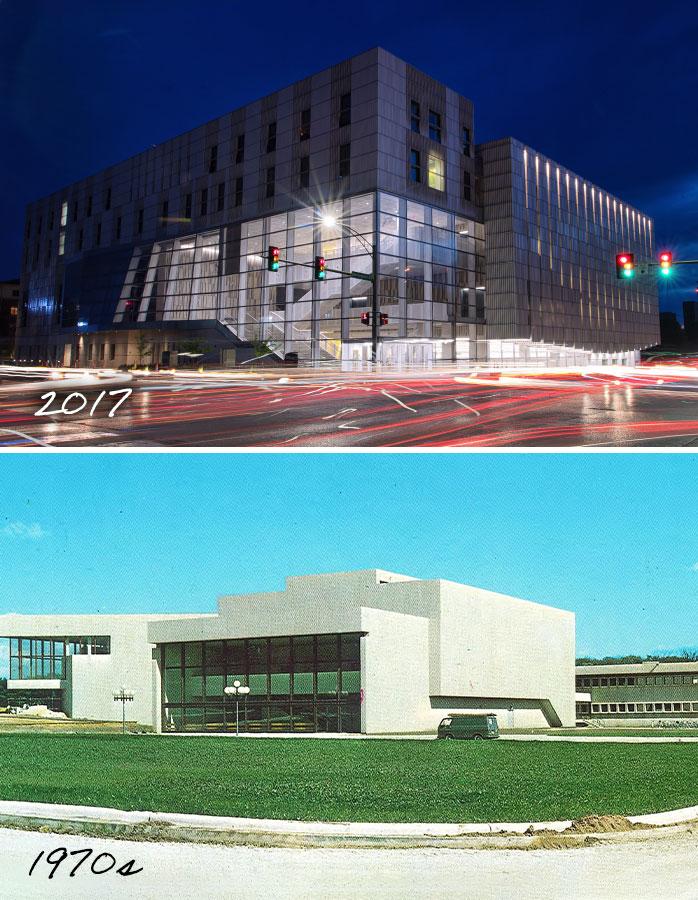 Click to enlarge
Click to enlarge
HAWKEYE COMMUNITY
PHOTOS: UI LIBRARIES SPECIAL COLLECTIONS AND UNIVERSITY ARCHIVES/JASON SMITH A view looking south from East Washington Street onto South Dubuque Street depicts a bustling Iowa City Downtown District throughout the ages.• WHERE WE STARTED:
Iowa City and the state of Iowa have grown up around its flagship public research university. After Iowa’s early leaders claimed this tract of land along the river in 1839 as the territorial capital and, soon after, the state capital, Iowa City became a hub for culture, commerce, and education. It remained so even when the statehouse relocated to Des Moines in 1857, making the capitol the university’s centerpiece.
From its earliest days, downtown Iowa City was a destination for scholars and artists who arrived aboard stagecoaches and steamboats, and later passenger rail and motor carriages. An urban renewal project in the 1970s transformed downtown into a vibrant pedestrian mall that has served as Iowa City’s living room ever since.
 Click to enlarge
Click to enlarge
• WHERE WE ARE:
Twenty-first century Iowa City consistently ranks among the nation’s best places to live and work thanks to its quality of life, educational opportunities, and cultural offerings. The ped mall, which saw extensive renovations this past decade, and the surrounding downtown district, is known for its lively mix of shops, restaurants, and nightlife. The nearby Riverfront Crossings district has been the focus of new development in recent years, while Coralville’s Iowa River Landing District has thrived with the addition of UI Health Care’s IRL clinic.
Beyond Johnson County, the UI is an economic powerhouse for the state and Iowa’s largest employer. According to a recent study commissioned by the State Board of Regents, the university supports one out of every 19 jobs in Iowa and adds $8 billion to the state’s economy.
• WHERE WE’RE GOING:
Several major UI facilities projects will have a positive impact on the greater Iowa City community in the coming years, including upgrades to the university housing and health care systems. The UI announced earlier this year that it’s exploring the possibility of selling its 55-year-old Mayflower Residence Hall, which is located more than a mile away from the Pentacrest, while studying options for a new residence hall specially tailored to returning students.
A sale could potentially reshape Iowa City’s North Dubuque Street gateway through the revitalization or redevelopment of the high-profile property. Meanwhile, UI Health Care continues to expand to meet the growing needs of Iowans. Its new campus in North Liberty will create new jobs and bring more patients from across Iowa to Johnson County for care.

